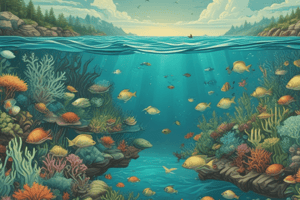Podcast
Questions and Answers
What is the shallow area of soil and water near the surface of a lake called?
What is the shallow area of soil and water near the surface of a lake called?
- Limnetic zone
- Benthic zone
- Littoral zone (correct)
- Profundal zone
What is the primary characteristic of the limnetic zone?
What is the primary characteristic of the limnetic zone?
Open water zone with no rooted plants.
What happens in the profundal zone regarding sunlight and producers?
What happens in the profundal zone regarding sunlight and producers?
No sunlight; therefore, no producers.
What is the benthic zone?
What is the benthic zone?
Flashcards are hidden until you start studying
Study Notes
Zones of Lakes and Ponds
-
Littoral Zone
- Shallow area near the surface of the water
- Rich in soil and supports various forms of life
- Home to algae and emergent plants, such as cattails
- Site of highest photosynthesis activity in aquatic ecosystems
-
Limnetic Zone
- Characterized by open water away from the shore
- Rooted aquatic plants cannot thrive due to depth
- Dominated by phytoplankton, the primary photosynthetic organism
- Extends to the depth of sunlight penetration, affecting its ecological characteristics
-
Profundal Zone
- Defined by the absence of sunlight, hence no photosynthetic producers
- Dominated by decomposing bacteria that break down organic material (detritus)
- Oxygen consumption by bacteria limits the presence of larger organisms
- Represents a deeper, darker habitat in lakes and ponds
-
Benthic Zone
- The muddy bottom layer of lakes, situated below the limnetic and profundal zones
- Composed of sediments which can host various organisms
- Acts as a critical habitat for decomposers and other bottom-dwelling life forms
Studying That Suits You
Use AI to generate personalized quizzes and flashcards to suit your learning preferences.




